Las 10 mejores mecánicas de juego para juegos hipercasuales
Cuando se te ocurren nuevas ideas de juegos, a menudo quieres mirar a tu alrededor en busca de inspiración. La mayoría de los grandes juegos suelen ser una combinación de dos mecánicas con un toque de innovación. Me gusta usar la regla 90/10. Cíñete al 90% de lo que sabes y trata de darle un giro del 10%. Como mencioné en el artículo de Voodoo, a Voodoo no le importa el diseño de tu juego , sino la percepción que el mercado tiene del diseño de tu juego . Para ellos, cualquier juego que tenga éxito es la forma en que crecerán, pero para los desarrolladores de juegos, la historia es una maestra valiosa y ver lo que funcionó en el pasado puede ayudar en el futuro.
Aquí hay un desglose de las 10 principales mecánicas de juego actuales para juegos hipercasuales en la tienda de aplicaciones y qué recordar al crear un juego usándolas.
También puede disfrutar de nuestro artículo de seguimiento, en nuestro artículo Las 7 principales mecánicas de juegos inactivos .
Mecánica de grifo/sincronización

Los juegos Tap and Timing son la forma más popular de mecánica para juegos hipercasuales. La mayoría de las otras mecánicas utilizan el toque o el tiempo como método de entrada para su juego particular. En un juego que es puro toque y sincronización, la mecánica se basa en un toque exacto o en un momento exacto. La precisión es el aspecto más importante de la acción y el objetivo para el usuario es la perfección. Sólo el toque perfecto traerá la puntuación máxima. El resto de los juegos sienten y la creatividad se basa en explotar pequeñas imprecisiones en el toque para reducir la capacidad del jugador para ganar, generalmente en forma de una puntuación alta. El juego Baseball Boy de Voodoo centra la atención del jugador en un solo golpe del bate de béisbol como la única acción que tiene el jugador. Cada golpe es estimulante, pero el golpe perfecto es dramáticamente mejor.
Al pensar en las mecánicas de toque y sincronización, debes eliminar cualquier factor externo o confuso para el jugador y proporcionar un objetivo visual claro que el jugador debe alcanzar. La retroalimentación visual es extremadamente importante aquí, con una representación clara de un mal tiro, pero también un gran refuerzo positivo para el tiro perfecto. Cuanto más clara sea la portería y más duro sea el tiro perfecto, más divertido será acertar.
Mecánica de apilamiento
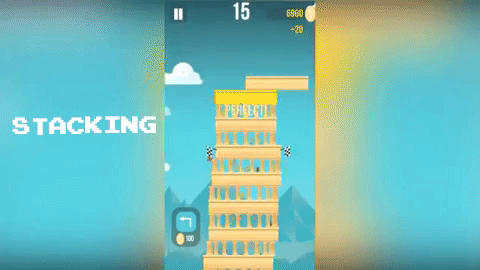
La mecánica de apilamiento lleva la mecánica de tap/timing un paso más allá al agregar el resultado de tus toques anteriores al progreso de la ronda. El juego The Tower de Ketchapp es un buen ejemplo en el que la propia Torre está formada por cuadrados previamente apilados. Cada vez que un jugador no logra conseguir una pila perfecta, la torre se encoge, haciéndola más difícil y más pequeña para la siguiente pila.
La mecánica de apilamiento proporciona más puntos de falla para los jugadores, y cada falla tiene un efecto menor que un juego Pure Tap. Suavizan la falla al permitirle continuar, pero mantienen la claridad visual de cómo ocurrió esa falla . Cuanto menos castiga el fallo , más largo será el asalto, pero los asaltos largos también significan una sensación de tranquilidad.
Cuando pienses en cómo diseñar un juego de pila en mente, asegúrate de que los jugadores tengan suficientes puntos de fallo (5-10) antes de terminar la ronda, pero asegúrate de que la dificultad sea lo suficientemente difícil como para que los jugadores obtengan tiempos no perfectos al menos 20- el 40% del tiempo.Con muy pocos puntos de fallo, el juego es demasiado difícil y con demasiados tiempos perfectos, el juego es demasiado fácil.
Mecánica de torneado

Girar es la última de las mecánicas temáticas de grifo y sincronización. Agrega una complicación adicional a cada toque al agregar una percepción visual confusa. La corteza visual humana tiene una debilidad inherente a la hora de juzgar longitudes entre formas horizontales y verticales en un espacio 3D. La corteza visual se puede engañar con bastante facilidad y muchas ilusiones visuales lo demuestran. La ilusión Ponzo es un buen ejemplo. Como diseñador, todavía solo le pides al jugador que cronometre un solo toque, pero con la confusión adicional del espacio 3D, es más probable que los jugadores se equivoquen. Esto es mucho más difícil de dominar que el enfoque basado en 2D Stack.
Un buen juego basado en turnos suele ser más indulgente que un juego basado en pilas, reiniciando al jugador con más frecuencia y permitiéndole volver a una racha perfecta incluso después de cometer errores. Como diseñador, quieres que tus jugadores cometan errores claros que terminen en fracaso; cuanto más obvios sean esos errores, menos frustrado se sentirá el jugador. Los juegos de giros también funcionan mejor cuando los ángulos son de 90 grados o se repiten ángulos agudos, simplemente porque el cerebro puede aprender a superar su propia debilidad mediante prueba y error. ¡Debes ser más indulgente que otras mecánicas de juego hipercasuales porque la gente simplemente no cree lo que ven sus propios ojos! Oh el poder de la mente
Mecánica de destreza
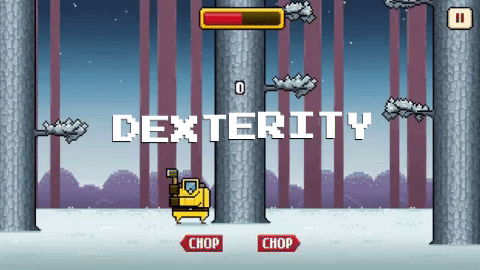
These games mainly focus on a player having a very simple and repeating action that they must perform many hundreds of times. With enough practice, these mechanics can be mastered by dextrous players and so the highest score is a fair representation of dexterity and skill. For these games to be fun the game must usually speed up, taking a mechanic that might be easy to slowly, but when pressurised by a time becomes more and more likely you will make a mistake.
You still need a clear hard limit to success usually a single life or single mistake ends the round and you start from the beginning. Timberman by Digital Melody is a great example of taking a player’s full attention, timing and dexterity to create a challenging points based challenge. When designing these sort of games you must make sure the controls and input sensitivity is the highest priority. There can be no lag and no grey areas, a players action will directly affect the character immediately. A player will be inputting many hundreds of taps per round, each tap must be accurate for it to be fun, any inaccuracies or lag are multiplied by the number of times you input it.
Rising / Falling Mechanics

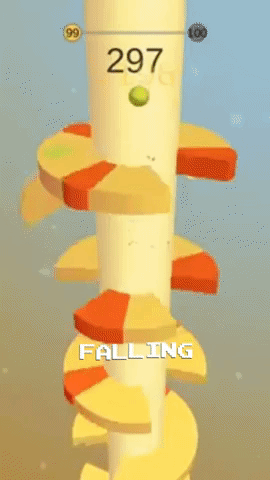
——
Rising and falling mechanics provide interesting journeys for their players. The constant progression of the level leads to the feeling of progression without a change in the mechanic or goal. To keep people entertained the level itself must develop. Rise Up by Serkan Özyılmaz and Helix Jump by Voodoo show how progression develops as you traverse up or down the game.
The player’s focus is on dealing with the next challenge along the progression and less about accuracy. There are many ways to win these levels, a little luck is often needed over timing or skill. Your only goal is to protect an object from a single point of failure.
The journey develops pressurising environments and the players end up creating lots of self-inflicted problems. Small issues early on can cause much harder moves later. Good design here focus’ on players have 1 or possibly 2 problems to deal with at a time, but the nature of the problem changes as you rise or fall through the gameplay. Try to think in stages and work on each stage being fun on it’s own, adding them together creates thedynamic journey.
Swerve Mechanics
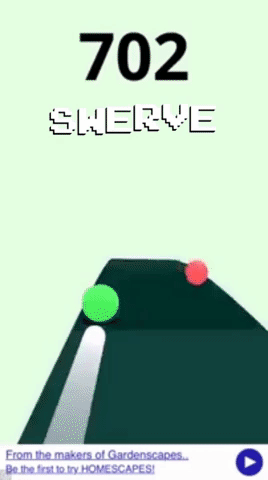
The final arcade based hypercasual mechanic is the swerve mechanic. These games focus on using the drag of a finger to avoid obstacles. Most of the time they are avoidance based mechanics in a similar vein to rising and falling, but they also focus more on dexterity than timing. Swerve gamesmaximise the touch screen controls and are hard to recreate on other devices. This gives them an original feeling and a cool use of touch inputs.
What’s important here is that the game focus’ on a playeraccuracy of inputfrom dragging and sweeping a finger, rather than timing a tap. The size of the object, the speed of the object has a big effect on what people are able to do with their fingers.
In the same way, as dextrous games focus on removing inaccuracies, swerve games need to focus on the inputfeel of your finger. Players will play for longer if the game feels fun and the near misses feel, super near. Work on making thegame reward players for near misses andreplay their errors to show just how close they were to almost avoiding death to make the game more fun.
Merging Mechanics

Merging mechanics are very easy for players to understand. Similar things combine, different things don’t. The game then becomes very easy for people to get right and with each subsequent merge, a new piece of understanding and a strong sense of progression is conveyed to players. Complexity and challenge in this game usually come in the form of a metagame, something that non-casual games rely on, but for the casual audience, the metagame can be divisive, making the game too complex and turning people away from playing.
Merge games do well because the metagame isincorporated into the main game. The mechanic isvery visual and you can see how your action is causing the merged units to be different from one another. For a merging game to be successful, don’t break the golden rule,embrace the golden rule– Similar things combine, different things don’t. You then need to make merging feel fun, animate, excite and surprise players with each new find. The clearsense of progressionalong with theever-increasing challenge,due toexponential growth, of merging to the next stage will keep people playing for longer.
Idle Mechanics

Idle as a mechanic has been used in hyper casual to mid-core games for a number of years. The complexity and reliance on the mechanic is a choice by each game designer. At its core, it is any mechanic that doesn’t require input from a player in order to progress. Obviously, no input at all is a very casual experience, but also one that without an objective becomes boring. Most of the time idle mechanics form a secondary mechanic attached to a soft currency. This works well because over time players earn more money which they can spend in their core game experience.
Adventure Capitalist by Hyper Hippo made the idle mechanic the core focus of the gameplay and built a game around repeating the mechanic with different growth rates. It became successful because of the interplay between the rates and the addition of ascension mechanics which force a player to lose all of their progress in the current game for increase speed of progress in the next game.
For idle mechanics to be fun, they need to be balanced. The biggest issue with the genre is bad maths. Either the game reaches incredibly hard to overcome peaks of progress or totally boring plateaus of progression where the numbers and growth mean nothing in the real game. Be careful and make sure you use your excel skills to their max if you want to rely on idle mechanics.
Growing Mechanics
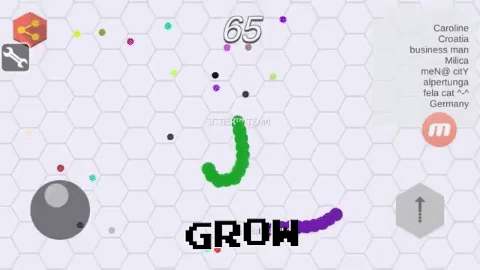
Growing mechanics are very similar to idle mechanics in that they are usually independent of the core control input but do form the core gameplay objective. Winners in this hyper casual genre are always the largest and in some cases can eat other players, in essence ending a round. The gameplay mechanics themselves are very clear, yet developing a fun experience and one that scales is reasonably difficult for this genre.
You need to think a lot about player density when designing games that grow. Obviously, all players want to grow, but not all can. Starting the correct number of players in the correct space and with the correct amount of food is what makes this genre fun. These games also become exponentially more fun with other real people playing them and have so far formed the .io genre on the store. The number of fitting gameplay mechanics for this genre is limited but the games have a longer lifespan than other hypercasual games because of the interactions with other players.
Puzzle Mechanics

Los rompecabezas son un género en sí mismo, pero los juegos de rompecabezas hipercasuales se centran en la simplicidad más que en la complejidad. Un buen juego de rompecabezas hiper casual generalmente no tiene fin . Simplemente se pide a los jugadores que continúen jugando el rompecabezas durante el mayor tiempo posible y el juego no aumentará la dificultad . La mecánica en sí debe crecer en complejidad a través de las acciones de los usuarios. ¡Buenos ejemplos son 1010! Por Gram Games o 2048 por Ketchapp . En ambos casos, las reglas del rompecabezas se establecen al principio y el tablero se desarrolla a medida que juegas. A diferencia de otros juegos de mesa como el ajedrez o las damas, que tienen objetivos finales claros, los juegos de rompecabezas hipercasuales generalmente no tienen un final claro y se trata simplemente de durar el mayor tiempo posible.
Estos son el género de juegos hipercasuales más difíciles de desarrollar porque suelen tener mecánicas muy claras y definidas que son exclusivas del juego en sí. Esto se debe a que es muy difícil crear una mecánica que con el tiempo no cambie el tablero de juego y lo convierta en algo demasiado fácil o demasiado difícil. Los juegos de mesa suelen ser un gran lugar para buscar mecánicas probadas, pero asegúrate de elegir aquellas que requieran muy pocas reglas, de lo contrario perderás a tu audiencia en la explicación.
Comparta en los comentarios si cree que hay otras mecánicas de juegos hipercasuales que vale la pena mencionar o cualquier otra idea de juegos hipercasuales que le guste y actualizaremos el artículo.
Leave a Reply